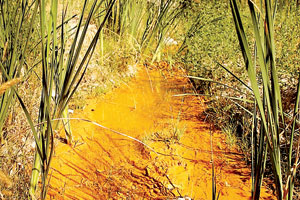Nearly 40 years after the historic mining town of New Idria was
closed, the federal government now might place the ghost town on a
clean-up list because of its toxic runoff. The mine, which pours
mercury into nearby waterbeds, has helped turn the water orange and
contaminate the San Carlos Creek and nearby fisheries, according to
a report from the United States Environmental Protection Agency.
The mercury runoff carries into the Panoche Creek and, eventually,
the San Francisco Bay.
Nearly 40 years after the historic mining town of New Idria was closed, the federal government now might place the ghost town on a cleanup list because of its toxic runoff.
The mine, which pours mercury into nearby waterbeds, has helped turn the water orange and contaminate the San Carlos Creek and nearby fisheries, according to a report from the United States Environmental Protection Agency. The mercury runoff carries into the Panoche Creek and, eventually, the San Francisco Bay.
Placement on the list will allow the EPA to use federal money to clean up the site that has poured contaminants into nearby rivers for 40 years, said Rusty Harris-Bishop, EPA communications coordinator for Superfund.
Because of the site’s threat to nearby wildlife, the EPA proposed to place the mine on a Superfund National Priorities List. The mine was closed in 1972 because of pollution from its waste, but it never has received an extensive cleanup.
The EPA had not placed the site on the list in the past because the agency wanted local and state officials to clean up the mine’s waste first, Project Manager Kelly Manheimer said.
“We try to have the local and state governments work on it first,” she said. “It’s appropriate for them because they know the area the best.”
Manheimer went on, “We push it to the local level as much as possible to have them address the impact.”
Throughout the years, the county and the California Sate Water Resources Control Board have searched for the owner of the site to implement cleanup, Manheimer said, but it hasn’t been successful.
The EPA investigated placing the site on the Superfund list in 1997, but backtracked after the state’s water board wanted to work on the site.
“It looked like the state was going to work on the site,” Manheimer said. “They wanted to take a shot at it.”
The state in 1997 proposed to clean up the site – but it never happened, Manheimer said.
During Tuesday’s county board meeting, Supervisor Robert Rivas expressed disgust that the county let the site become such an issue.
Reading from a prepared statement, Rivas called the site an “environmental catastrophe.”
“The site in San Benito County is one of the nation’s worst polluted places,” Rivas said. “Yes, right here in our own backyard.”
Rivas asked why something wasn’t done sooner.
“It’s about time. I hate to say this, but something like this would never be allowed to happen in a place like Monterey or Santa Cruz or Santa Barbara,” he said. “Environmentalists would have fought tooth and nail to make sure that their land was protected.”
Earlier in March, the EPA added 10 new sites to the Superfund list – raising the total sites to 1,290 in the U.S.
New Idria was listed along with an additional 15 proposed sites.
To receive federal money for cleanup, the EPA must go through a series of steps, studying the area for the best remedies, Harris-Bishop said. The studies are expected to start in the coming months, and will finish before the end of the year.
The EPA is planning to present to the board of supervisors in the next month, and will begin to set up public comment sessions.
“We want to be as open with the public as possible,” Manheimer said. “We want the public’s input.”
For a story on the fire that ravaged New Idria in 2010, go here.
For a story on a historical buff trying to buy the site, go here.










